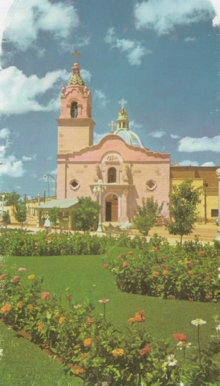Magdalena de Kino

Magdalena de Kino (Spanish pronunciation: [maɣðaˈlena ðe ˈkino] ) is a city, part of the surrounding municipality of the same name, located in the Mexican state of Sonora covering approximately 560 square miles (1,460 square kilometers). According to the 2005 census, the city's population was 23,101, and the municipality's was 25,500. Magdalena de Kino is in the northern section of Sonora 50 miles (80 kilometers) from the Mexico-U.S. border. To the north the municipality abuts Nogales; to the south, the municipality of Santa Ana; to the east, Ímuris and Cucurpe; and to the west, the municipalities of Tubutama and Sáric. Its main sectors include San Ignacio, San Isidro, Tacicuri, and Sásabe. The city was named after the pioneer Roman Catholic missionary and explorer, Father Eusebio Francisco Kino, who worked in the area, as well as in the present-day US state of Arizona.
History
[edit]
Originally, the territory was populated by the Papagos (Tohono O'odham) and Pimas (Akimel O'odham). The first missions were established in 1687, with the arrival of Eusebio Francisco Kino.[citation needed]
Mission Santa María Magdalena was Kino's personal headquarters from about 1690. Construction of mission buildings took place beginning in 1705, under the supervision of Agustín de Campos. Upon Kino's death in 1711, he was buried in the chapel.[1] The municipal seat was founded at the beginning of the 18th century by Lieutenant Juan Bautista Escalante.[citation needed]
Native raiders repeatedly destroyed the mission complex during the eighteenth century. It was rebuilt in 1730,[1] and destroyed again in 1757.[citation needed] Raiders attacked again in 1776, when Pedro Font was the missionary in residence.[1]
Economy
[edit]Agriculture is a key economic activity throughout the municipality. Of the 3,300 acres (13 km2) of arable land, 2,800 (approximately 85%) are irrigated. Crops include fruit, wheat, maize, common bean and sorghum. Cattle ranching is also an important source of income within the municipality. Mission Garden in Tucson, Arizona, includes an area that shows historical Mexican influences on the region's agriculture. The design of that area reflects modern-day Magdalena de Kino.
The industry employs approximately 2,000 individuals, primarily at the various maquiladoras. In addition, the city's businesses produce beverages, construction and furniture.
Primary tourist attractions
[edit]Magdalena de Kino has 6 hotels and 6 bars/restaurants and several sites of interest to tourists, including:
- The Temple of Santa María Magdalena, with an image of San Francisco Xavier, is an important historical figure for both Sonora and the neighboring U.S. state of Arizona.
- The Grave of Father Kino, who died in the year 1711 is interred in a crypt near the mission he founded. The monument was constructed in 1966 after the discovery of Father Kino's remains.[2]
- The Father Kino Museum, with architectural designs by Marco Antonio Ortez, where objects of the indigenous cultures of the region are exhibited, including photographs, weaponry and clothing.
- The Mausoleum of Luis Donaldo Colosio Murrieta and his wife Diana Laura Riojas de Colosio, is located in the municipal pantheon.
- Numerous buildings are constructed of stone with engravings reflecting the history of the municipality and Mexico in general.
Notable people
[edit]- Luis Donaldo Colosio - (born Magdalena de Kino) presidential candidate, PRI movement member, assassinated in Tijuana in 1994.
- Alejandro Gallardo - (born Magdalena de Kino) soccer player, World Cup winner in Peru U-17 in 2005. Currently plays in F.C. Atlas
- Brothers Luis and Ramón Urías - (born Magdalena de Kino) professional baseball players who have played in the MLB.
References in popular culture
[edit]Magdalena de Kino is the subject of a song by The Killers frontman, Brandon Flowers. 'Magdalena' appears on his solo album Flamingo.
Magdalena de Kino was also a filming site for Fast and The Furious.
International relations
[edit]Twin towns – Sister cities
[edit]Magdalena de Kino is twinned with:
Notes
[edit]- ^ a b c Stockel, Henrietta (September 15, 2022). Salvation Through Slavery: Chiricahua Apaches and Priests on the Spanish Colonial Frontier. University of New Mexico Press. ISBN 978-0-8263-4327-7.
- ^ Polzer, C. 1968. A Kino Guide: His Missions – His Monuments. Southwestern Mission Research Center, Tucson AZ.
- ^ "Sister Cities, Public Relations". Guadalajara municipal government. Archived from the original on March 2, 2012. Retrieved March 12, 2013.
References
[edit]- Link to tables of population data from Census of 2005 INEGI: Instituto Nacional de Estadística, Geografía e Informática
- Sonora Enciclopedia de los Municipios de México
External links
[edit]- (in Spanish) Official website of Magdalena de Kino, Sonora
- (in English and Spanish) Tourism Commission of Sonora — About Magdalena de Kino
- (in English) Mission Santa Maria Magdalena — and Padre Kino's tomb.
